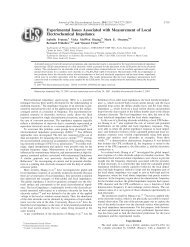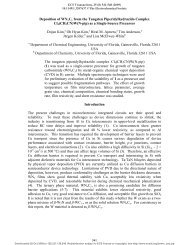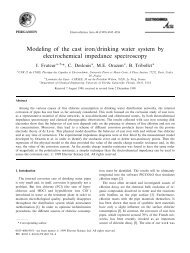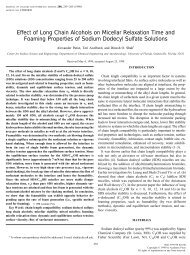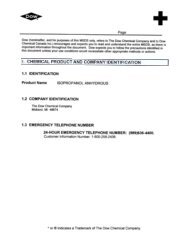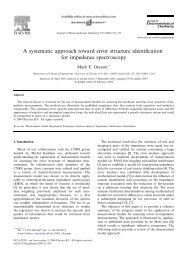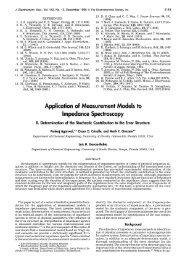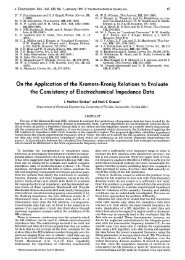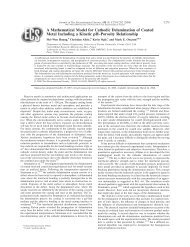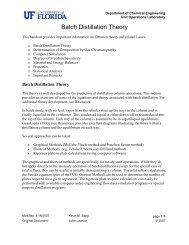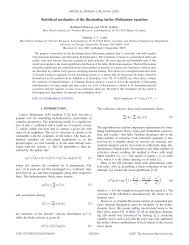Lattice-Boltzmann Model with Sub-Grid-Scale Boundary Conditions
Lattice-Boltzmann Model with Sub-Grid-Scale Boundary Conditions
Lattice-Boltzmann Model with Sub-Grid-Scale Boundary Conditions
You also want an ePaper? Increase the reach of your titles
YUMPU automatically turns print PDFs into web optimized ePapers that Google loves.
VOLUME 84, NUMBER 10 PHYSICAL REVIEW LETTERS 6MARCH 2000<strong>Lattice</strong>-<strong>Boltzmann</strong> <strong>Model</strong> <strong>with</strong> <strong>Sub</strong>-<strong>Grid</strong>-<strong>Scale</strong> <strong>Boundary</strong> <strong>Conditions</strong>R. Verberg and A. J. C. Ladd*Chemical Engineering Department, University of Florida, Gainesville, Florida 32611-6005(Received 4 November 1999)A lattice-<strong>Boltzmann</strong> method has been developed to incorporate solid-fluid boundary conditions onlength scales less than the grid spacing. By introducing a continuous parameter, specified at each nodeand representing the fluid volume fraction associated <strong>with</strong> that node, we obtain second-order accuracyfor boundaries at arbitrary positions and orientations <strong>with</strong> respect to the grid. The method does notrequire surface normals, and can therefore be applied to irregular geometries such as porous media. Thenew rules conserve mass and momentum, and reduce to the link bounce-back rule at aligned interfaces.PACS numbers: 47.11.+j, 47.15.Gf, 47.55.Mh, 83.85.PtIn this Letter we present a fundamental improvement tothe conventional lattice-<strong>Boltzmann</strong> method, which incorporatesinformation about the solid surface on scales lessthan the resolution of the grid. In most lattice-<strong>Boltzmann</strong>simulations the solid-fluid boundary conditions are modeledby the bounce-back rule, in which particles encounteringa solid surface are reflected back in the directionthey came from. However, discretization of the solid surfaceintroduces particular problems in simulations wherethe surface morphology is evolving due to erosion or depositionof dissolved solids [1]. In such cases, changes tothe solid surfaces cannot be modeled smoothly, but onlyin discrete units of the grid spacing. To simulate thesesystems we have devised a new boundary condition for thelattice-<strong>Boltzmann</strong> method in which the location of the solidsurface can change continuously, on scales less than thegrid spacing. The new boundary rules, which we call continuousbounce-back (CBB) rules, are an extension of thelink or midway bounce-back (LBB) method [2] to includethe reflections of distributed population densities from partiallyfilled cells. We present numerical results that demonstratethat second-order accurate results can be obtainedfor flow in narrow channels where the walls are not commensurate<strong>with</strong> the grid. We also show that grid artifacts insimulations of flows past curved surfaces (disks or spheres)are much reduced by the CBB rules. Finally, we show thatthe flow patterns in a narrow fracture are less sensitive togrid size than in the LBB method.In the lattice-<strong>Boltzmann</strong> method, the state of the systemis characterized by the discretized velocity distributionfunction n i r, t, which describes the number of fluidparticles at a lattice node r at time t <strong>with</strong> a velocityc i . The mass density rr, t and the momentum densityjr, t are moments of n i r, t: rr, t P i n i r, t andjr, t P i c i n i r, t. We use a volumetric interpretation[3,4] in which n i r, t represents the mean populationdensity in the Wigner-Seitz cell surrounding node r. Thetime evolution of the distribution function in the bulk fluidis the same as in the conventional model; n i r 1 c i , t 11 n i r, t 1D i r, t 1 f i r, t, where f i r, t incorporatesthe effect of external forces. Our simulations usethe Bhatnagar-Gross-Krook collision operator D i r, t 2t 21 n i r, t 2 n eqi r and an equilibrium distribution,n eqi r, appropriate to Stokes flow [2]. In this work wetake t 1, giving a kinematic shear viscosity n 16.To simulate the interactions between fluid and solid,the lattice-<strong>Boltzmann</strong> model must be modified to incorporatethe boundary conditions imposed on the fluid bythe solid phase. Our new scheme is based on the linkbounce-back method, in which the boundary nodes lie midwaybetween the solid and fluid nodes [2]. For planarsurfaces it can be shown that the hydrodynamic boundaryis located at the boundary nodes, <strong>with</strong> deviations thatare second order in the lattice spacing [5]. Several othermethods to obtain second-order accurate boundary conditionshave been suggested in the literature [6–12], butthey are not easily applied to irregular geometries. Themethod described in this Letter is fundamentally differentfrom most previous schemes in that it attempts to modelsolid-fluid surfaces that are not mapped directly onto thelattice grid. In addition, it shares the important advantageof the bounce-back rule that it does not require surfacenormals. Instead, we introduce a continuous variable,ar, specified at each node and representing the fluid volumefraction associated <strong>with</strong> that node, and then constructrules relating the velocity distribution function after propagation,n i r 1 c i , t 1 1, to the postcollision distributionni r, t n i r, t 1D i r, t 1 f i r, t.We begin <strong>with</strong> an extension of the LBB method to twodimensionalchannel flows where the solid-fluid boundariesare parallel to a lattice symmetry direction, but are notnecessarily commensurate <strong>with</strong> the cell boundaries. Weintroduce the basic concepts by assuming that the populationdensities are uniformly distributed throughout thevolume of the cell surrounding each node. Particles arepropagated from each point in a cell by one lattice spacingper time step. If the channel wall coincides <strong>with</strong> aface of a cell, we have the typical LBB rule [cf. Fig. 1(a)].Here, n1r 1 , t is completely reflected at the interface betweencells 1 and 2, so that n 2 r 1 , t 1 1 n1r 1 , t. Ifcell 2 instead contains a fraction of fluid a 2 [cf. Fig. 1(b)],n1r 1 , t is split into three different fractions, each one2148 0031-90070084(10)2148(4)$15.00 © 2000 The American Physical Society
VOLUME 84, NUMBER 10 PHYSICAL REVIEW LETTERS 6MARCH 2000FIG. 1. Schematic representation of the different geometriesdiscussed in the text. The gray areas represent the solid phase,the arrows indicate the population densities after propagation ofn1r 1 , t, and the solid dots indicate the location of the meanpopulation density in each cell or fraction of a cell. The populationdensities n 1 and n 2 are moving to the right and left,respectively. The heavy lines in (c) and (d) indicate an inclinedboundary represented by the sequence of partially filled cells.translating over a distance of one lattice spacing and reflectingat the solid-fluid interface at the appropriate time,i.e., for a 2 , 0.5 [cf. Fig. 1(b)],n 1 r 2 , t 1 1 n 1r 1 , t ,(1a)shown in Fig. 1(b). The propagation of ni x, t from eachlocation, x, again consists of a translation in the directionof c i over a distance of one lattice spacing and reflectionat the interface at the appropriate time. An example of theresulting propagation rule isn 1 r 2 , t 1 1 1 Z a 2 212na1x, t dx2212 2n 1r 1 , t 1 a 2 2 1n1r 2 , t; (3)a 2 1 1the other integrals can be evaluated in a similar fashion.The CBB rules were tested for Poiseuille flow in channelsthat were shifted <strong>with</strong> respect to the underlying lattice.In Fig. 2(a), we show the flow profile for Poiseuille flowin a channel of width L P r[L ar 3, driven bya pressure gradient = y p. It can be seen that even for anarrow channel the agreement <strong>with</strong> the analytic result isgood; the largest deviations occur for channels shiftedby one-half of a lattice spacing and are of the order of10%. The mean relative error in the flow profile, eL L P 21 r[L arj y r, L 2 j y r, L ! ` 2 12 j 0 , decreasesas 1L 2 , as shown in Fig. 2(b). For L $ 5, eLis less than 4%, while the error in the location of thehydrodynamic boundary is less than 0.05 lattice spacings.We obtained similar results for Poiseuille flow in channelsof noninteger widths.n 2 r 2 , t 1 1 n 1r 1 , t ,(1b)1.61.2(a)L = 3n 2 r 1 , t 1 1 1 2 2a 2 n1r 1 , t1a 2 n1r 2 , t 1 n2r 2 , t .j y(x)/j 00.8(1c)0.4If cell 2 is more than half full of fluid a 2 . 0.5 noneof the reflected population density is returned to cell 1, andEqs. (1b) and (1c) must be modified accordingly. Equation(1) correctly accounts for the mass transfer between cellsof different fluid fractions and reduces to the LBB rule[Fig. 1(a)] when a 2 ! 0. However, the fluid velocity inthe partially filled cells is only first-order accurate.We proceed to a better approximation by taking into accountthe velocity gradient in the direction of propagation.Assuming that the population density varies linearly alongthe line connecting cells 1 and 2,ni x, t 2x ni r 2 , t 2 ni r 1 , t 1 ni r 1 , t ,1 1a 2(2)for i 1, 2. Here we have taken the origin at the centerof cell 1, <strong>with</strong> the positive x axis pointing in the c i direction.The mean population density of cell 2 lies midwaybetween the wall and the interface between cells 1 and 2, asε(L)0.00 1 x 2 30.25(b)0.200.150.100.050.000.0 0.1L -2 0.2 0.3FIG. 2. Poiseuille flow in a shifted channel. (a) Flow profilej y x for a channel width L 3; the theoretical mean momentumflow j 0 L 2 = y p12n. (b) Mean relative error eL in theflow profile. The open circles are the simulation results for alattice where the wall coincides <strong>with</strong> the interface between twocells. The solid symbols are for lattices shifted <strong>with</strong> respect tothe wall in increments of 110: in increasing order these gofrom solid circles (0.1) to diamonds (0.5). The solid lines indicatethe asymptotic 1L 2 decay of eL.2149
VOLUME 84, NUMBER 10 PHYSICAL REVIEW LETTERS 6MARCH 2000In most situations of practical interest the systemchanges rapidly from fluid to solid, typically <strong>with</strong> onlyone partially filled cell in between. However, morecomplicated geometries do arise, in which the solid-fluidinterface extends over more than one cell. We approximatean inclined boundary extending over two cells by the geometryshown in Fig. 1(c), so that during the propagationstep a fraction of the population density is reflected incell 1, while the remainder bounces back in cell 2. Thepropagation rule for n1r 1 , t now consists of the sum oftwo contributions, each of them determined by the samebasic rules discussed in reference to Fig. 1(b). The fluidfraction (a) is updated by substituting a 2 g 12 for a 2 inEq. (3) and the analogous expressions for n 2 r 2 , t 1 1and n 2 r 1 , t 1 1; g 12 a 1 1a 2 2 sets the barrierheight across the boundary between cells 1 and 2. Inthe geometry shown in Fig. 1(c), if the wall defining (b)is separated by less than half a lattice spacing from theinterface between cells 0 and 1, the fluid fraction (b) istotally reflected, and then propagated to cell 0.We have performed a series of tests for Poiseuille flowin inclined channels, where the boundaries and pressuregradient were placed at an angle u <strong>with</strong> respect to oneof the lattice vectors; in one case tanu 34 and L 245 and 485, and in the other case tanu 1 and L 7 p 2 and 14 p 2. For both inclinations, eL was about8% for the smaller channel width and 3% for the larger. Incontrast, the LBB method is very sensitive to the locationof the interface relative to the position of the nodes. Forexample, for tanu 1 and L 7 p 2, the flow profileis about 40% too large if the half-occupied boundary cellsare considered to be fluid and about 50% too small if theyare treated as solid.A drawback of the proposed boundary condition is thatthe limits for a 1 ! 1 or a 2 ! 0 are not continuous; theshoulder in cell 2 of height 1 2g 12 [Fig. 1(c) vanishes discontinuouslywhen a 1 1. Although a different choice ofg 12 can prevent this discontinuity, we made this particularchoice to maintain a continuous profile in the general caseshown in Fig. 1(d). We have numerically tested the impactof this discontinuity and found that it is small.Finally, we consider the most general geometry, shownschematically in Fig. 1(d). Here we consider only thecase a 1 .a 2 ; the update rule for a 1 #a 2 is fullpropagation <strong>with</strong> mass conservation, i.e., n 1 r 2 , t 1 1 a 1 n1r 1 , ta 2 . Although Fig. 1(d) is drawn for a 0 .a 1and a 2 .a 3 , our results are equally valid for arbitraryvalues of a 0 and a 3 . The propagation rule for thepostcollision distribution in cell 1 now consists of the sumof three contributions. The fluid fraction (a) is propagatedto cell 2, while the fractions (b) and (c) are updated ina manner similar to that described for the two cell case[Fig. 1(c)]. The complete CBB rules, including limitingcases, will be discussed in detail in a future publication.We tested the most general CBB rules by simulatingfluid flow through periodic arrays of disks and spheres,which utilize a mixture of the different types of boundaryconfigurations. In each case we have calculated themean momentum flow j y V P 21 r[V arj y r ina unit cell of length L, driven by a pressure gradient= y p. In Fig. 3, we plot the reduced drag coefficientF D 2L 2 = y pn j y of a square array of disks as afunction of the radius of the disk R 3L8. The resultsshow two important improvements over the LBB method:(i) The drag coefficient obtained <strong>with</strong> the CBB rules isvirtually independent of the position of the center of thedisk <strong>with</strong> respect to the lattice, and (ii) the error in F D ismuch smaller and the convergence to the asymptotic valueis second order. For a cubic array of spheres the spread inF D was even smaller than for disks, most probably dueto a higher degree of averaging over the different types ofboundaries.The CBB rules have also been tested by simulating fluidflow in a realistic fracture geometry. A marble cylinderwas split into two halves and the surface profile of eachhalf was measured using mechanical profilometry [14]. Byreplacing the two halves <strong>with</strong> a small offset, an irregularfracture profile was obtained <strong>with</strong> a mean fractureheight H 0.324 mm. The dimensions of the samplewere 32 3 32 3 4 mm. The in-plane resolution of theprofilometer was 0.25 mm and the height measurementwas accurate to about 15 mm. The flow was driven by apressure gradient = y p, and the sample was jacketed aroundthe xy and yz faces. An 0.25 mm thick fluid layer wasadded to each end of the specimen in the flow y directionand periodic boundary conditions were applied. TheF DF D4003503002502001501004003503002502001501000 3 6 9 12 15FIG. 3. Reduced drag coefficient F D of a square array of disks,obtained <strong>with</strong> the CBB rules (a) and LBB rules (b), for differentpositions of the center of the disk <strong>with</strong> respect to the lattice: inthe center of a cell , in the corner of a cell , and at tworandom positions ( and ). The solid line is the theoreticalresult [13] at the same porosity, 9p64 0.442.R(a)(b)2150
VOLUME 84, NUMBER 10 PHYSICAL REVIEW LETTERS 6MARCH 2000steady state momentum density jr was integrated over acolumn spanning the entire height of the fracture to givethe total in-plane momentum flow j p r. Three differentspatial resolutions D 0 n were used, <strong>with</strong> D 0 0.25 mmand n 1, 2, and 4. To compare results at different spatialresolutions a constant cross section of 0.25 3 0.25 mmwas used for each column; results at the higher resolutionsn 2 and 4 were therefore averaged over blocks of 4 and16 columns, respectively. Since the mean fracture heightis small, an accurate simulation of the flow in this geometrywould seem to require a much higher resolution inthe height (z direction) than in the horizontal xy plane.However, results obtained using the CBB rules show thataccurate flow profiles can be obtained <strong>with</strong> only 2–3 cellsacross a typical channel width; the LBB method requiresabout twice as many cells for comparable accuracy.In Fig. 4(a), we plot the y component of the mean flow j p,y and the flow field j p,y r at two random positions.The discretization inherent in the LBB method causes thenarrowest channel to be completely blocked at the lowestresolution, whereas the CBB rules already give a reasonablemomentum flow. Figure 4(b) shows that the CBBrules describe the rms velocity fluctuations <strong>with</strong> a meanerror of about 10% at the lowest resolution, whereas <strong>with</strong>the LBB method the error is almost 80%. Contour plots ofthe flow field illustrate this point more clearly [15]. Usingthe CBB rules, the lowest resolution simulation containsmost of the details of the flow field, although the averageheight of the fracture is only about 1.3 lattice spacings.In this Letter we have introduced a new set of boundaryrules for the lattice-<strong>Boltzmann</strong> model, which allow for areduction in resolution by a factor of 2 to 4; in three dimensionalsimulations a factor of 2 reduction in resolutiontranslates into at least a 16-fold reduction in computer timeand an 8-fold reduction in memory. Although the continuousbounce-back rules are more complicated to implement,the additional computational overhead is small. The keyadvance is that the accuracy of the new boundary conditionsis insensitive to the actual position of the interface<strong>with</strong> respect to the lattice. We anticipate that the mostimportant applications of this idea will be to simulationsof changes in morphology in porous media, arising fromerosion or deposition of solid carried by the fluid. Themethod can be adopted to simulations of particle suspensionsby modifying the reflected population densities totake account of the moving interface [2].We thank Dr. William Durham (Lawrence LivermoreNational Laboratories) for providing us <strong>with</strong> the fractureimagedata. This work was supported by the U.S. Departmentof Energy, Office of Basic Energy Sciences(DE-FG02-98ER14853). / j 0; j p,y(r) / j 0∆j p/ j 0432100.60.50.40.30.20 1 2 3 4 5nFIG. 4. (a) The mean flow j p,y j 0 (circles) and flow fieldj p,y rj 0 at two random positions, one where the fracture heightis approximately half (triangles) and one where it is approximatelydouble (squares) the mean fracture height. (b) Velocityfluctuations perpendicular (Dj p,x j 0 : circles) and parallelDj p,y j 0 : squares) to = y p. Here, j 0 H 2 = y p12n, <strong>with</strong> themean fracture height H 0.324 mm. The open and closed symbolsare simulation results using the LBB and the CBB rules,respectively.(a)(b)*Electronic address: tladd@ufl.edu[1] J. A. Kaandorp, C. P. Lowe, D. Frenkel, and P. M. A. Sloot,Phys. Rev. Lett. 77, 2328 (1996).[2] A. J. C. Ladd, J. Fluid Mech. 271, 285 (1994).[3] R. Benzi, S. Succi, and M. Vergassola, Phys. Rep. 222, 145(1992).[4] H. Chen, Phys. Rev. E 58, 3955 (1998).[5] X. He, Q. Zou, L.-S. Luo, and M. Dembo, J. Stat. Phys.87, 115 (1997).[6] P. A. Skordos, Phys. Rev. E 48, 4823 (1993).[7] D. R. Noble, S. Y. Chen, J. G. Georgiadis, and R. O. Buckius,Phys. Fluids 7, 203 (1995).[8] T. Inamuro, M. Yoshino, and F. Ogino, Phys. Fluids 7, 2928(1995).[9] R. S. Maier, R. S. Bernard, and D. W. Grunau, Phys. Fluids8, 1788 (1996).[10] S. Chen, D. Martinez, and R. Mei, Phys. Fluids 8, 2527(1996).[11] Q. Zou and X. He, Phys. Fluids 9, 1591 (1997).[12] H. Chen, C. Teixeira, and K. Molvig, Int. J. Mod. Phys. C9, 1281 (1998).[13] A. S. Sangani and A. Acrivos, Int. J. Multiph. Flow 8, 193(1982).[14] W. B. Durham and B. P. Bonner, Int. J. Rock Mech. Min.Sci. Geomech. Abstr. 30, 699 (1993).[15] These contour plots may be seen at www.che.ufl.edu/ladd/Research/Porous/<strong>Sub</strong><strong>Grid</strong>.htm.2151



